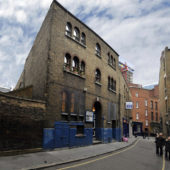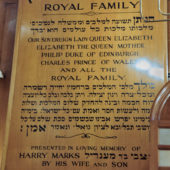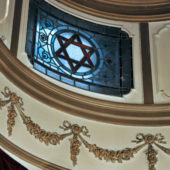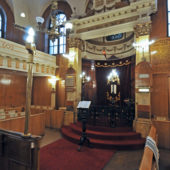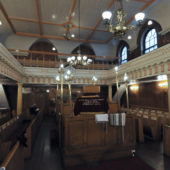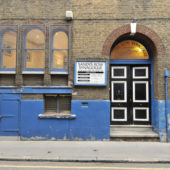Built as a Huguenot church, the Sandys Row Synagogue is one of the earliest surviving examples of a chapel converted for Jewish worship.
Sandy’s Row Synagogue is in Spitalfields, a small neighborhood in the east end of London which has been home to waves of immigrants stretching back to the 16th century. In 1853 a group of poor Dutch Ashkenazi immigrants formed a mutual aid and burial insurance society. The members comprised cigar makers, diamond cutters and fruit traders. By 1867 the group had grown to five hundred members. Seeking a place to pray, they purchased a formerly a French Chapel, originally established by French protestants who had fled Catholic persecution in the late 17th century. Called L’Eglise de l’Artillerie (the Artillery Church), it is located on Artillery Street, so named because at the time of Henry VIII when the street was laid, the artillery practiced there.
The building’s renovation from a church into a synagogue was opposed by London’s established synagogues, because they thought that the new immigrants should join one of the established congregations. However, these poor, immigrant Jews of the East End felt very strongly about having their own synagogue. At the rate of a penny per week per family, they were able to raise enough money to purchase and renovate L’Eglise de L’Artillerie into Sandys Row Synagogue.
The building was particularly suitable because it had a balcony and an east-west axis, although facing westwards. The group hired architect Nathan S. Joseph to remodel the former church. The old entrances had to be bricked-up and a new entrance made, so that the Aron Kodesh could be placed against the southeast wall, facing towards Jerusalem. Sandys Row Synagogue is the oldest Ashkenazi synagogue in London. It was “once the home of the Jewish East End and the home of its renaissance.” The building itself is nearly 250 years old and is Grade II listed. The leading Sephardi rabbi, from Bevis Marks Synagogue, Hahan Benjamin Artom, consecrated the Ashkenazi Sandys Row Synagogue.
The building was refurbished in 1922 and in 2009 it was awarded further funds from the UK’s Large English Heritage Grant, to make further restorations possible. The synagogue hosts live music, community and heritage events. Its congregation participates in Jewish, London and National Heritage Open days. The congregation offers lunchtime minyan (prayer groups), bi-weekly Shabbat services, regular tours, women’s minyan, evening cultural activities, in addition to possibly creating an East End Heritage Educational center. The synagogue itself retains a wealth of artifacts from its early beginnings.
Sandy Row’s Synagogue is a three-story, rectangular Georgian brick building 48 feet by 36 feet. The relatively flat façade is punctuated with arched windows on all three stories and the lower 3 feet of the front is inexplicably painted blue. The décor of the Georgian styled prayer room is modeled after the the Great Synagogue in London. The walls are paneled in wood, and it features a white coved ceiling with orange accent, cornicing, clerestory windows and a Neo-classical hand-carved carved mahogany Aron Kodesh set into an apse. The Aron Kodesh is spectacular, with double rectangular marble Corinthian pilasters on either side, with gold capitals, an ivory crossbar with two tablets featuring the Ten Commandments inscribed in Hebrew above. The deep red pelmet and Torah curtain with gold embroidery is drawn across. In the center of the prayer room is the bimah, with simple wood panel surround. The tivah (reader’s desk) is situated inside of the bimah, covered with a deep red velvet throw featuring gold embroidery. The women’s gallery is upstairs, running along the sides and back of the sanctuary. Ivory colored carved wood panels with orange trim separate the gallery from the sanctuary. Simply carved pine pews fill the sanctuary. The interior remains faithful to its original construction in the 19th century.
More historical background about the Spitalfields neighborhood:
The Great Fire of London occurred in 1666, devastating the city, prompting the first development of Spitalfields. In 1685, King Louis XIV of France outlawed Protestantism in favor of Catholicism. As a result, French Protestants fled to England, settling largely in Soho and Spitalfields, and were nicknamed “Huguenots” by their Catholic pursuers.
The Queen was aware that many of the Huguenots came from Lyon, a silk weaving center in France and that their silk weaving skills would improve the garment industry in London. The Huguenots’ presence in Spitalfields caused friction, as the Queen had houses especially built for them. The houses were tall and thin, with a French shutter, an attic window and a place where a weaver could keep his loom. The idea was that the attic room would let in as much light as possible. The weavers’ houses are still found in Spitalfields, the street names give them away: Fournier Street, Nantes Passage, Princelet Street and Fleur-d-Lys. Popular Brick Lane is nearby. The Huguenots dominated the weaving industry in Britain for about two centuries, until industrialization was introduced.
In 1881 the first of what became a series of pogroms began in the Ukraine. The pogroms comprised an orchestrated series of violent acts against the Jewish people, their homes, property and businesses. These of course, spread all over Europe. Millions of Jews fled Russia and Germany in the late 19th century to London and Spitalfields. However, Spitalfields was already overcrowded, due to the recent destruction of working-class homes to make way for the Liverpool Street railway line. Therefore, the new immigrants were treated with hostility and blamed for taking jobs and pushing up house prices. These immigrant Jews, who were poor and mostly uneducated, began making a living in textiles and furniture. They were kosher butchers, ran kosher restaurants and set up synagogues; there are still Jewish two bagel shops on Brick Lane.
As these Jewish immigrants became more prosperous, they would move out of East London to the suburbs of north London, such as Golders Green, Hendon and Finchley. For the past 500 years, Spitalfields’ inhabitants have struggled to make ends meet and many have lived lives of deprivation, poverty and in slums. However, due to London’s growing financial center nearby, the economic life Spitalfields is improving. There is now a great deal of new development makng Spitalfields a dynamic section of London’s old east end.

